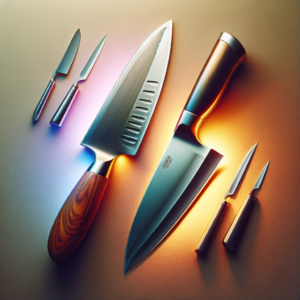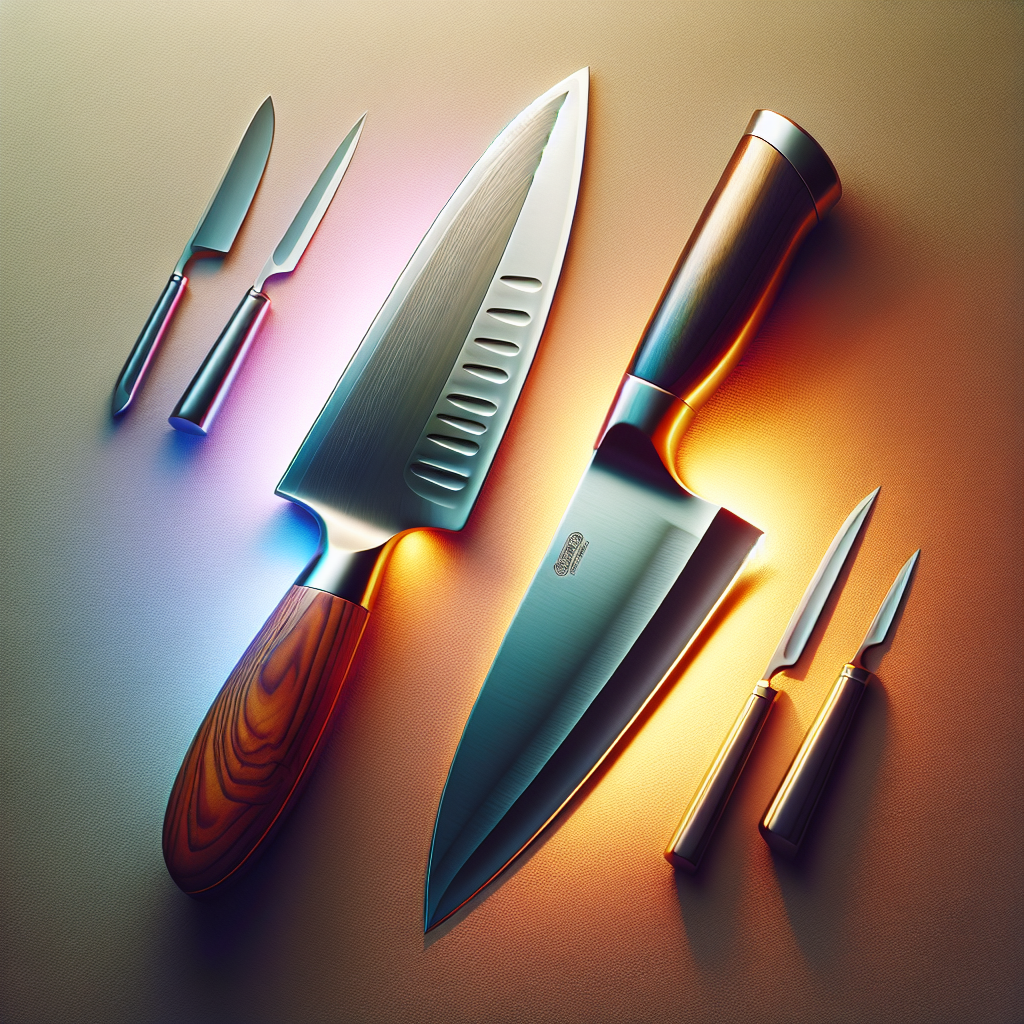What’s The Difference Between A Chef’s Knife And A Santoku Knife?
November 20, 2023

When it comes to the world of kitchen knives, the options can seem overwhelming. But fear not, because we’re here to clear up the confusion and guide you through the key differences between two popular choices: the chef’s knife and the Santoku knife. Both are essential tools for any home cook, but understanding their unique features and uses will help you make the right choice for your culinary adventures. So, grab your apron and get ready to upgrade your knife knowledge!
What’s The Difference Between A Chef’s Knife And A Santoku Knife?
If you’re an avid cook or even just someone who enjoys spending time in the kitchen, you’ve probably come across the terms “chef’s knife” and “Santoku knife” before. These two types of knives are both incredibly popular and versatile in the culinary world, but they do have some distinct differences that make them better suited for certain tasks. In this article, we’ll dive into the key differences between a chef’s knife and a Santoku knife, exploring their size, blade shape, length, thickness, edge, tip, weight and balance, purpose and versatility, cutting techniques, as well as their respective price ranges.

Size
One of the first noticeable differences between a chef’s knife and a Santoku knife is their size. A chef’s knife typically has a longer and wider blade, measuring around 8 to 10 inches in length. This larger size makes the chef’s knife ideal for tasks that require more strength and power, such as chopping through meats and larger vegetables. On the other hand, a Santoku knife is slightly shorter, usually ranging from 5 to 7 inches in length. This smaller size allows for greater precision and control, making it an excellent choice for slicing, dicing, and mincing ingredients.
Blade Shape
Another key difference lies in the blade shape of these two knives. A chef’s knife typically has a curved blade, allowing for a rocking motion when cutting. This curved shape is ideal for tasks like mincing garlic or finely chopping herbs. On the contrary, a Santoku knife features a straighter blade, making it better suited for push-cutting techniques. The straight edge of the Santoku knife allows for cleaner cuts when slicing through ingredients like meat or root vegetables.
Blade Length
As mentioned earlier, the length of the blade is an important factor to consider when comparing chef’s knives and Santoku knives. Chef’s knives generally have longer blades, which can be beneficial for tasks that require slicing through larger and denser ingredients. The longer blade allows for more surface area to come into contact with the food, resulting in smoother and quicker cuts. Santoku knives, with their shorter blades, are more versatile when it comes to precision tasks, making them a great choice for smaller ingredients or intricate cuts.
Blade Thickness
When it comes to blade thickness, chef’s knives and Santoku knives also differ. A chef’s knife typically has a thicker and heavier blade compared to a Santoku knife. The thickness of a chef’s knife allows for more durability and strength, making it suitable for tasks that involve heavy-duty cutting or slicing through tough ingredients. On the other hand, Santoku knives tend to have thinner and lighter blades, allowing for greater agility when performing fine, delicate cuts.
Blade Edge
The design of the blade edge is another significant distinction between these two knife types. A chef’s knife often features a double-edged blade, meaning it is sharpened on both sides, creating a V-shape. This double-edged design allows for more versatility and ease when using different cutting techniques. In contrast, a Santoku knife typically has a single-edged blade, sharpened on one side, creating a flat edge. This flat edge provides precise control and excellent grip, making it ideal for precision slicing and dicing.
Pointed Tip vs Flat End
The tip of the knife is yet another factor where chef’s knives and Santoku knives differ. Chef’s knives generally have a pointed tip, which can be useful for tasks that require piercing, such as removing seeds or deboning meat. The pointed tip also allows for detailed and intricate work. In contrast, Santoku knives have a flat end rather than a pointed tip. This flat end provides stability and safety during slicing and dicing, making it easier to keep the blade steady on the cutting board.
Weight and Balance
Weight and balance play a significant role in the usability and comfort of a knife. Chef’s knives are typically heavier due to their larger size and thicker blade. This added weight helps to provide better control and stability when cutting through dense ingredients. On the other hand, Santoku knives are generally lighter, allowing for more agility and maneuverability in intricate tasks. The balanced weight distribution of a knife is also crucial. Both chef’s knives and Santoku knives strive to achieve a well-balanced design to minimize fatigue and ensure a comfortable grip during extended use.
Purpose and Versatility
While both chef’s knives and Santoku knives are highly versatile, they do have some differences in terms of their intended purposes. Chef’s knives are considered a true workhorse in the kitchen, capable of tackling a wide range of tasks from slicing and dicing to chopping and mincing. They excel in heavy-duty cutting and can handle larger and denser ingredients with ease. On the other hand, Santoku knives are known for their precision and delicate cutting capabilities. They are perfect for tasks that require finesse, such as creating thin slices, intricate cuts, and precise dices.
Cutting Techniques
The differences in blade shape, length, and thickness influence the cutting techniques best suited for each knife. Chef’s knives are excellent for implementing the rocking technique, where you can use the curved edge to quickly chop through ingredients by rocking the blade back and forth. The rocking motion allows for efficient and consistent cuts when working on larger ingredients. Conversely, Santoku knives excel in push-cutting techniques, where you slide the blade straight through the ingredient in a clean and controlled manner. The straight edge and smaller size of the Santoku knife enhance precision and accuracy during push cuts.
Price
Lastly, the price range is an important aspect to consider when deciding between a chef’s knife and a Santoku knife. Chef’s knives, with their larger size and heavier construction, tend to be more expensive compared to Santoku knives. The increased weight, wider blade, and overall durability contribute to the higher price tag. However, it’s worth noting that the price of a knife can vary significantly depending on the brand, material, and craftsmanship.
In conclusion, while both chef’s knives and Santoku knives are must-have kitchen tools, they have distinct differences that set them apart. The choice ultimately depends on your personal preference, preferred cutting techniques, and the specific tasks you frequently perform in the kitchen. A chef’s knife is perfect for those who require a versatile, powerful tool for a wide variety of tasks, while a Santoku knife is a great option for those who value precision, control, and agility for more delicate cuts. Whether you’re a professional chef or an enthusiastic home cook, having both knives in your collection will undoubtedly elevate your culinary experience.
